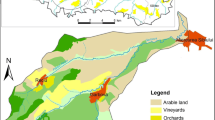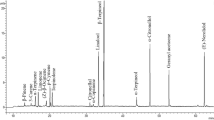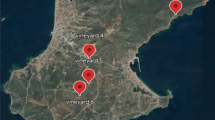Abstract
Spatial variability of temperature was studied in relation to the berry basic composition and secondary compounds of the Tannat cultivar at harvest from vineyards located in Canelones and Montevideo, the most important wine region of Uruguay. Monitoring of berries and recording of temperature were performed in 10 commercial vineyards of Tannat situated in the southern coastal wine region of the country for three vintages (2012, 2013, and 2014). Results from a multivariate correlation analysis between berry composition and temperature over the three vintages showed that (1) Tannat responses to spatial variability of temperature were different over the vintages, (2) correlations between secondary metabolites and temperature were higher than those between primary metabolites, and (3) correlation values between berry composition and climate variables increased when ripening occurred under dry conditions (below average rainfall). For a particular studied vintage (2013), temperatures explained 82.5% of the spatial variability of the berry composition. Daily thermal amplitude was found to be the most important spatial mode of variability with lower values recorded at plots nearest to the sea and more exposed to La Plata River. The highest levels in secondary compounds were found in berries issued from plots situated as far as 18.3 km from La Plata River. The increasing knowledge of temperature spatial variability and its impact on grape berry composition contributes to providing possible issues to adapt grapevine to climate change.






Similar content being viewed by others
References
Anderson JD, Jones GV, Tait A, Hall A, Trought MCT (2012) Analysis of viticulture region climate structure and suitability in New Zealand. J Int Sci Vigne Vin 46:149–165
Asselin C, Barbeau G, Morlat R (2001) Approche de la composante climatique à diverses échelles dans le zonage viticole. Bull OIV 74:301–318
Baciocco KA, Davis RE, Jones GV (2014) Climate and Bordeaux wine quality: identifying the key factors that differentiate vintages based on consensus rankings. J Wine Res 25(2):75–90
Barnuud NN, Zerihun A, Gibberd M, Bates B (2014) Berry composition and climate: responses and empirical models. Int J Biometeorol 58:1207–1223
Blanco-Ward D, García Quejeiro JM, Jones GV (2007) Spatial climate variability and viticulture in the Miño River Valley of Spain. Vitis 46:63–70
Bonada M, Sadras VO (2015) Review: critical appraisal of methods to investigate the effect of temperature on grapevine berry composition. Aust J Grape Wine Res 21:1–17
Bonnardot V, Planchon O, Cautenet S (2005) The sea breeze development under an offshore synoptic wind in the South Western Cape and implications for the Stellenbosch wine producing area. Theor Appl Climatol 81:203–218
Bonnefoy C, Quénol H, Bonnardot V, Barbeau G, Madelin M, Planchon O, Neethling E (2013) Temporal and spatial analyses of temperature in a French wine-producing area: the Loire Valley. Int J Climatol 33:1849–1862
Carbonneau A, Moueix A, Leclair N, Renoux J (1991) Proposition d’une mèthode de prélèvement de raisin à partir de l’analyse de l’hétérogenité de maturation sur un cep. Bull OIV 64:679–690
Clingeleffer PR (2010) Plant management research: status and what it can offer to address challenges and limitations. Aust J Grape Wine Res 16:25–32
Ferrer M, Pedocchi R, Michelazzo M, González-Néves G, Carbonneau A (2007) Delimitación y descripción de regiones vitícolas del Uruguay en base al método de clasificación climática multicriterio utilizando índices bioclimáticos adaptados a las condiciones del cultivo. Agrociencia Uruguay 11:47–56
Fourment M, Bonnardot V, Planchon O, Ferrer M, Quénol H (2014) Circulation atmosphérique locale et impacts thermiques dans un vignoble côtier: observations dans le sud de l’Uruguay. Climatologie 11:47–64
Glories Y, Augustin M (1993) Maturité phénolique du raisin, conséquences technologiques: application aux millésimes 1991 et 1992. Proceedings of the Compte Rendu Colloque Journée Techn. CIVB, Bordeaux
González-Néves G, Ferrer M, Gil G, Charamelo D, Balado J, Barreiro L, Bochicchio R, Gatto G, Tessore A (2010) Estudio plurianual del potencial polifenólico de uvas Tannat. Agrociencia Uruguay 14:10–21
Goto-Yamamoto N, Mori K, Numata M, Koyama K, Kitayama M (2009) Effects of temperature and water regimes on flavonoid contents and composition in the skin of red-wine grapes. J Int Sci Vigne Vin, special issue Macrowine:75–80
Hall A, Jones GV (2010) Spatial analysis of climate in winegrape growing regions in Australia. Aust J Grape Wine Res 16:389–404
Huglin P (1978) Nouveau mode d’évaluation des possibilités héliothermiques d’un milieu viticole. In: Proceeding Symposium International sur l’ecologie de la Vigne. Ministère de l’Agriculture et de l’Industrie Alimentaire, Contança
Hunter JJ, Bonnardot V (2011) Suitability of some climatic parameters for grapevine cultivation in South Africa, with focus on key physiological processes. S Afr J Enol Vitic 32:137–154
INAVI (2015) Instituto Nacional de Vitivinicultura. Estadísticas de los viñedos en http://www.inavi.com.uy/categoria/102-datos-nacionales-2015.html Accessed 11 March 2016
INIA (2015) Instituto Nacional de Investigación Agropecuaria. In: http://www.inia.uy/investigaci%C3%B3n-e-innovaci%C3%B3n/unidades/GRAS/Clima/Banco-datos-agroclimatico Accessed 20 April 2016
Jackson DI, Lombard PB (1993) Environmental and management practices affecting grape composition and wine quality: a review. Am J Enol Vitic 44:409–430
Jones GV, Duff AA, Hall A, Myers JW (2010) Spatial analysis of climate in winegrape growing regions in the Western United States. Am J Enol Vitic 61:313–326
Kliewer WM (1973) Berry composition of Vitis vinifera cultivars as influenced by photo-temperatures and nycto-temperatures during maturation. J Am Soc Hortic Sci 98:153–159
Kottek M, Grieser J, Beck C, Rudolf B, Rubel F (2007) World map of the Köppen-Geiger climate classification updated. Meteorol Z 15:259–226
Madelin M, Bois B, Quénol H (2014) Variabilité topoclimatique et phénologique des terroirs de la montagne de Corton (Bourgogne). In: Quénol H (ed) Changement climatique et terroirs viticoles. Lavoisier, Paris, pp 215–227
Matese A, Crisci A, Di Gennaro SF, Primicerio J, Tomasi D, Marcuzzo P, Guidoni S (2014) Spatial variability of meteorological conditions at different scales in viticulture. Agric For Meteorol 189-190:159–167
Mori K, Goto-Yamamoto N, Kitayamam M, Hashizume H (2007) Loss of anthocyanins in red-wine grape under high 877 temperature. J Exp Bot 58:1935–1945
Nicholas KA, Matthews MA, Lobell DB, Willits NH, Field CB (2011) Effect of vineyard-scale climate variability on Pinot noir phenolic composition. Agric For Meteorol 151:1556–1567
OIV (1990) Recueil des méthodes internationales d’analyse des vins et des moûts. Office International de la Vigne et du Vin, Paris
Quénol H (2014) Changement climatique et terroirs viticoles. Lavoisier, Paris, p 444
Sadras VO, Petrie PR, Moran MA (2012) Effects of elevated temperature in grapevine. II juice pH, titrable acidity and wine sensory attributes. Aust J Grape Wine Res 19:107–115
Sweetman C, Sadras VO, Hancock RD, Soole KL, Ford CM (2014) Metabolic effects of elevated temperature on organic acid degradation in ripening Vitis vinifera fruit. J Exp Bot 65:5975–5988
Tonietto J (1999) “Les macroclimats viticoles mondiaux et l'influence du mésoclimat sur la typicité de la Syrah et du Muscat de Hambourg dans le sud de la France”, PhD thesis, Université de Montpellier 2, France 236p
Tonietto J, Carbonneau A (2004) A multicriteria climatic classification system for grape-growing regions worldwide. Agric For Meteorol 124:81–97
Winkler AJ, Cook JA, Kliewer WM, Lider LA (1974) General viticulture. University of California Press, Berkeley
Acknowledgements
We are grateful to the following grapevine growers for providing limitless access to their vineyards (Establecimiento Juanicó, Bodega Pisano, Pizzorno Wine States, Bodega Bouza, and Bodega La Estancia). Comments and suggestions of two anonymous reviewers were also much appreciated.
Author information
Authors and Affiliations
Corresponding author
Ethics declarations
We declare that the experiment complies with the current laws of Uruguay. This article does not contain any studies with human participants or animals performed by any of the authors.
Conflict of interest
The authors declare that they have no conflict of interest.
Rights and permissions
About this article
Cite this article
Fourment, M., Ferrer, M., González-Neves, G. et al. Tannat grape composition responses to spatial variability of temperature in an Uruguay’s coastal wine region. Int J Biometeorol 61, 1617–1628 (2017). https://doi.org/10.1007/s00484-017-1340-2
Received:
Revised:
Accepted:
Published:
Issue Date:
DOI: https://doi.org/10.1007/s00484-017-1340-2




